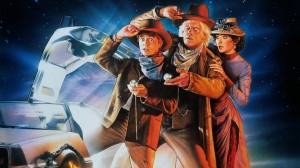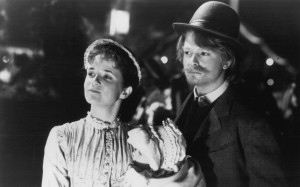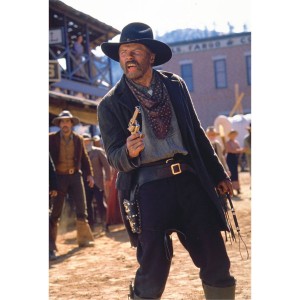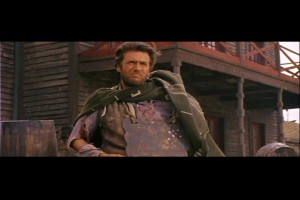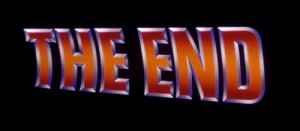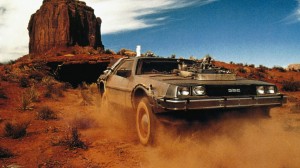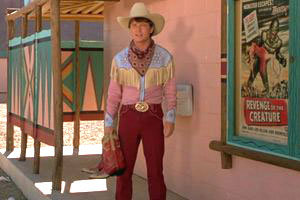100 Film Favorites – #21: Back to the Future Part III
(Robert Zemeckis, 1990)
Okay, first thing’s first: I know a lot of Back to the Future fans will probably regard this as blasphemy. Literally every countdown I’ve seen ranks Back to the Future Part II above Part III. So perhaps this is the first selection on this list which is empirically “wrong.” But I stand by it.
The film opens where its predecessor left off, with a stranded Marty beseeching the Doc Brown of 1955 for help. After recovering from his faint, 50s Doc has some reasonable questions, such as why “the me of the future is now in the past.” Eventually, he agrees once again to help Marty get “back to the future.” The two recover the Delorean time machine from a desert cave where 80s Doc (stuck in Wild West times) stashed it 70 years earlier. 50s Doc repairs the time machine with contemporary parts (vacuum tubes and whitewall tires), and advises Marty to return to 1985 and destroy the Delorean, as 80s Doc requested in his letter. However, Marty opts to travel to 1885 instead, in the hopes of rescuing his friend.
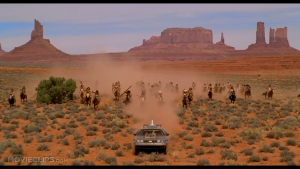
Marty’s time jump lands him in the midst of an Indian raid, and an errant arrow pierces the Delorean’s fuel line. As the only gasoline in the era seeps into the desert sand, Marty must ditch the car and walk into town. On the outskirts, he stumbles upon the farm of his own ancestors, Irish immigrants Seamus and Maggie McFly (those wacky McFly genetics again – Seamus is played by Michael J. Fox, and Maggie by Lea Thompson, who also plays Marty’s mother Lorraine). Marty borrows some “proper” clothes from Seamus and continues on his way.
The Hill Valley of 1885 is remarkably familiar. All the town’s well-known characters have 1880s ancestors: In addition to the McFlys, there’s lawman Marshall Strickland (forebear of Marty’s discipline-obssessed Principal Strickland), and a mention of carriages made by the Statler family (who own an auto dealership in the 1950s and 80s, and a hovercar conversion service in the 2010s. And of course, there has to be a Tannen. In this case, it’s Biff’s great-grandfather, scruffy outlaw Buford “Mad Dog” Tannen. Part of Marty’s urgency to rescue Doc stems from a news article he read in the 50s, which revealed that Mad Dog killed Brown six days after the letter was written.
Marty rendezvous with Doc, now serving as the town’s blacksmith. Doc agrees to return with Marty to 1985, but there’s a little problem: Just as a lack of plutonium in the first film required Doc & Marty to find a creative way to power the Delorean’s “time circuits,” now the duo must find a way to accelerate the machine to the requisite speed of 88 miles per hour without the use of gasoline. Doc proposes using a locomotive to push the car up to speed.
While investigating the remote section of track they plan to use for their “experiment,” the time-hopping twosome spots a runaway carriage headed toward the edge of a gorge. Doc manages to save the passenger, schoolmarm Clara Clayton…who in the “normal” timeline was the gorge’s namesake, due to her death. But now she’s alive, and she and Doc begin falling for each other.
Mad Dog Tannen makes his move to assassinate Doc at a party (his horse threw a shoe, for which Tannen blames blacksmith Doc). But Marty interferes, and becomes the new target of Tannen’s rage. The outlaw challenges Marty to a duel the next morning, and Marty accepts after being called a “yellow-belly.”
That night, Doc admits to Clara that he is from the future and plans to return there. She is furious and hurt that he would tell such an outrageous lie simply to break things off with her. Doc is despondent. Setup for the train heist continues apace, but on the morning of the operation Doc and Marty are waylaid one last time, when Mad Dog arrives for the scheduled duel. Marty, however, takes Seamus’ advice and finally learns to ignore Tannen’s taunts, dismissing him as “an asshole.” When Mad Dog corners him and forces him to fight, Marty prevails by wearing an improvised bulletproof vest made of a boiler-plate (borrowing a bit from a Clint Eastwood film shown in Part II).
Doc and Marty head to the desert and steal the locomotive. Meanwhile, Clara has discovered Doc’s model depicting the “experiment” and realizes he was telling the truth. She hurries on horseback to catch up with the train, which is gradually accelerating due to special high-heat logs concocted by Doc. Marty climbs into the speeding Delorean, but Doc notices Clara’s arrival and doubles back to save her when she nearly falls off the train. At the last moment, Doc swoops back on the hoverboard, plucking Clara off the side of the locomotive just as the Delorean hits 88 mph and disappears through time, and the train plummets to the bottom of the gorge.
Back in 1985, Marty and the Delorean appear on the tracks of the train trestle now spanning the gorge. Marty barely has time to dive for cover before a modern train comes lumbering through and smashes the time machine to smithereens. Though disappointed by the loss of Doc and the Delorean, Marty is relieved to find the world of the “good 1985” restored. He returns home and turns down Needles’ challenge to a drag race, even after being called “chicken,” and thereby avoids the accident which destroyed his guitar-playing ability in the “normal” timeline.
Just as Marty reunites with Jennifer, the familiar crackling sound of time travel is heard. Suddenly, the locomotive appears, restored to pristine condition and bearing some distinctly sci-fi add-ons, including a Mr. Fusion. Doc and Clara emerge, accompanied by their two sons, Jules and Verne. Doc reveals that he will no longer need to worry about a shortage of gasoline, as the train runs on steam. Doc gives Marty a photograph of the two of them posing in front of the newly-constructed clock-tower at the party in 1885. Finally, partly in regard to the avoided accident, Doc reminds Marty and Jennifer that “Your future hasn’t been written yet. No one’s has. The future’s whatever you make it. So make it a good one.”
Waving farewell for now, Doc and his family climb back aboard the time-train. It turns out to also be equipped with a hover conversion, and the film ends with the locomotive taking flight and soaring toward the screen, mirroring the final shot of the first film. Triumphant text proclaims,
So why does Part III rank above Part II? For one, it gets creative with its setting, perhaps the most distinctive era explored in the series. If you were to make a list of points in history that it would be interesting to time-travel to, I doubt that “the 80s” or “the 50s” would be first on your list. But I suspect that “cowboy times” WOULD be way up there, just behind “dinosaur times.” Indeed, the idea for Part III grew out of a discussion between Zemeckis and Michael J. Fox on the set of the first film. Fox said that if he could time travel to any one period, he would want to experience the Wild West. The setting allowed the crew to try new things, including performing all manner of horse-based stunts and capturing the renowned vistas of monument valley.
Also, whereas Part II has the characters schlepping through recreations of the exact same scenes from the first film, Part III pays homage to its predecessors a bit more creatively, with multiple scenes cleverly echoing those in the first film: Doc builds a model of the planned time travel escapade, but “doesn’t have time to build it to scale or paint it;” Clara comes calling on a flustered Doc at his workshop, mirroring a scene in which Lorraine does the same to a scandalized Marty. Admittedly, plenty of situations from the original Back to the Future are alluded to in Part II as well. These many intricate threads of running gags throughout the series give the sense of a detailed film-world and a cohesive narrative across all three installments. It’s also neat and somewhat unusual among trilogies that each of the “parts” begins exactly where the previous installment left off. Combined with the “echoed scenes,” this gives a sense that the trilogy is almost closer to a single six-hour movie rather than a series. Aside from the introduction of the weird “chicken” subplot, Parts II and III flow fairly seamlessly with the first film, and together the films form a triumphant triptych of time-travel.
Picking one Part over the others is difficult, but that’s the position I’m in. A final word on my ranking decision: like Return of the Jedi, I enjoy Part III because it brings closure to the saga. By the end, the protagonists have found success and happiness. With or without a time machine, the future looks bright.
Tidbits:
-One of the many in-jokes / running gags throughout the trilogy is the appearance in each film of a musician who performs a song on that movie’s soundtrack. In the original film, Huey Lewis (who performs “Power of Love” and “Back in Time”) plays a Battle of the Bands judge who criticizes Marty’s band for being “just too darn loud.” In Part II, Michael Jackson (who performs “Beat It”) plays a hologram waiter at the Cafe 80s. And in Part III, Z.Z. Top (who perform “Doubleback”) play the band at the 1885 dance party.
-Clint Eastwood, famous for playing Western anti-hero “the man with no name,” is referenced multiple times throughout Part III, with Marty even adopting Eastwood’s name in the 1880s to hide his identity as a McFly. But perhaps the best Eastwood reference comes while still in 1955 – Marty, decked in flamboyant “cowboy clothes,” questions whether pink paisley is really period-authentic. “C’mon,” he says, “Clint Eastwood never wore anything like this.” As he says this, Marty walks by a sign for a drive-in movie theater. The theater happens to be showing Revenge of the Creature, the first sequel to The Creature from the Black Lagoon…and the first film to feature a young Clint Eastwood.
Brian Terrill is the host of television show Count Gauntly’s Horrors from the Public Domain. You can keep up with Brian’s 100 Film Favorites countdown here.


